Entrepreneurship & Small Business: Ventures, Impact on Social Economy
VerifiedAdded on 2024/06/27
|15
|3897
|171
Essay
AI Summary
This essay provides a comprehensive analysis of entrepreneurial ventures, exploring their various types, including public, private, and social enterprises, and their relation to the topology of entrepreneurship. It highlights the similarities and differences between these ventures based on roles, funding, objectives, hiring practices, and benefits. The essay also assesses the impact of micro and small businesses on the national economy using relevant data and statistics, emphasizing their significance in fostering social economy growth. It delves into how these businesses contribute to job creation, innovation, and overall economic development, ultimately improving the lifestyle of the people and serving the society.

ENTREPRENEURSHIP AND SMALL BUSINESS
MANAGEMENT
1
MANAGEMENT
1
Paraphrase This Document
Need a fresh take? Get an instant paraphrase of this document with our AI Paraphraser
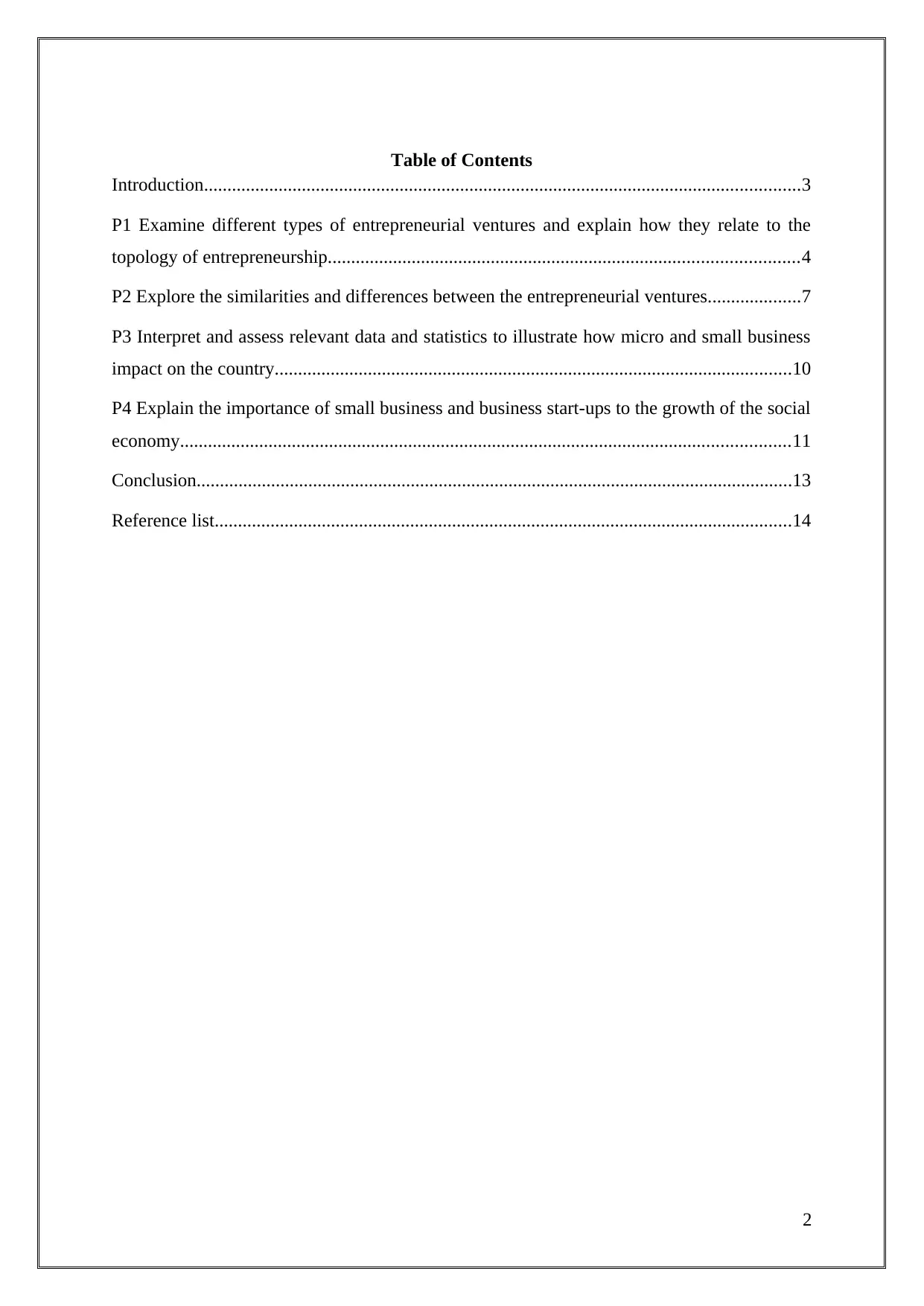
Table of Contents
Introduction................................................................................................................................3
P1 Examine different types of entrepreneurial ventures and explain how they relate to the
topology of entrepreneurship.....................................................................................................4
P2 Explore the similarities and differences between the entrepreneurial ventures....................7
P3 Interpret and assess relevant data and statistics to illustrate how micro and small business
impact on the country...............................................................................................................10
P4 Explain the importance of small business and business start-ups to the growth of the social
economy...................................................................................................................................11
Conclusion................................................................................................................................13
Reference list............................................................................................................................14
2
Introduction................................................................................................................................3
P1 Examine different types of entrepreneurial ventures and explain how they relate to the
topology of entrepreneurship.....................................................................................................4
P2 Explore the similarities and differences between the entrepreneurial ventures....................7
P3 Interpret and assess relevant data and statistics to illustrate how micro and small business
impact on the country...............................................................................................................10
P4 Explain the importance of small business and business start-ups to the growth of the social
economy...................................................................................................................................11
Conclusion................................................................................................................................13
Reference list............................................................................................................................14
2
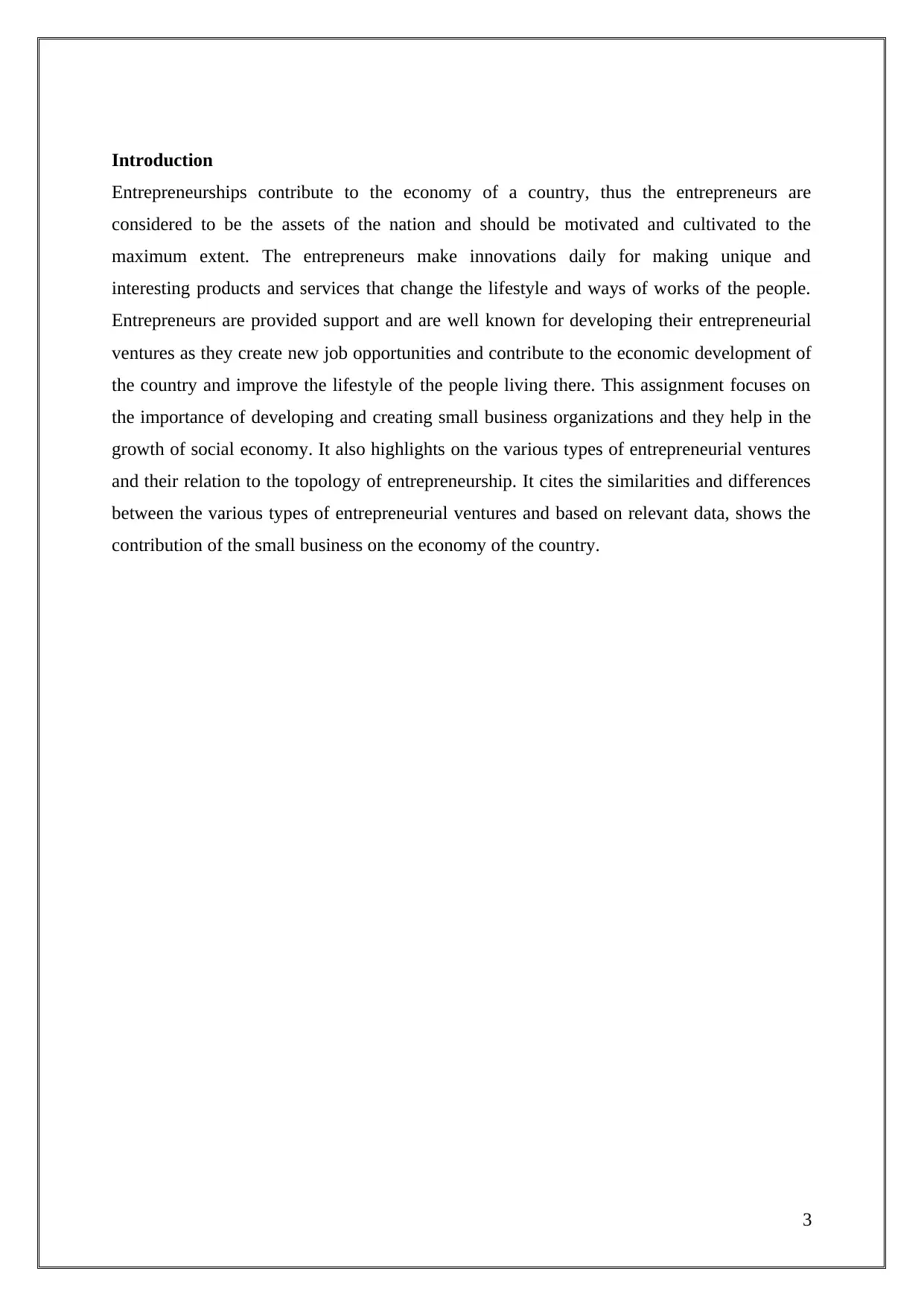
Introduction
Entrepreneurships contribute to the economy of a country, thus the entrepreneurs are
considered to be the assets of the nation and should be motivated and cultivated to the
maximum extent. The entrepreneurs make innovations daily for making unique and
interesting products and services that change the lifestyle and ways of works of the people.
Entrepreneurs are provided support and are well known for developing their entrepreneurial
ventures as they create new job opportunities and contribute to the economic development of
the country and improve the lifestyle of the people living there. This assignment focuses on
the importance of developing and creating small business organizations and they help in the
growth of social economy. It also highlights on the various types of entrepreneurial ventures
and their relation to the topology of entrepreneurship. It cites the similarities and differences
between the various types of entrepreneurial ventures and based on relevant data, shows the
contribution of the small business on the economy of the country.
3
Entrepreneurships contribute to the economy of a country, thus the entrepreneurs are
considered to be the assets of the nation and should be motivated and cultivated to the
maximum extent. The entrepreneurs make innovations daily for making unique and
interesting products and services that change the lifestyle and ways of works of the people.
Entrepreneurs are provided support and are well known for developing their entrepreneurial
ventures as they create new job opportunities and contribute to the economic development of
the country and improve the lifestyle of the people living there. This assignment focuses on
the importance of developing and creating small business organizations and they help in the
growth of social economy. It also highlights on the various types of entrepreneurial ventures
and their relation to the topology of entrepreneurship. It cites the similarities and differences
between the various types of entrepreneurial ventures and based on relevant data, shows the
contribution of the small business on the economy of the country.
3
⊘ This is a preview!⊘
Do you want full access?
Subscribe today to unlock all pages.

Trusted by 1+ million students worldwide
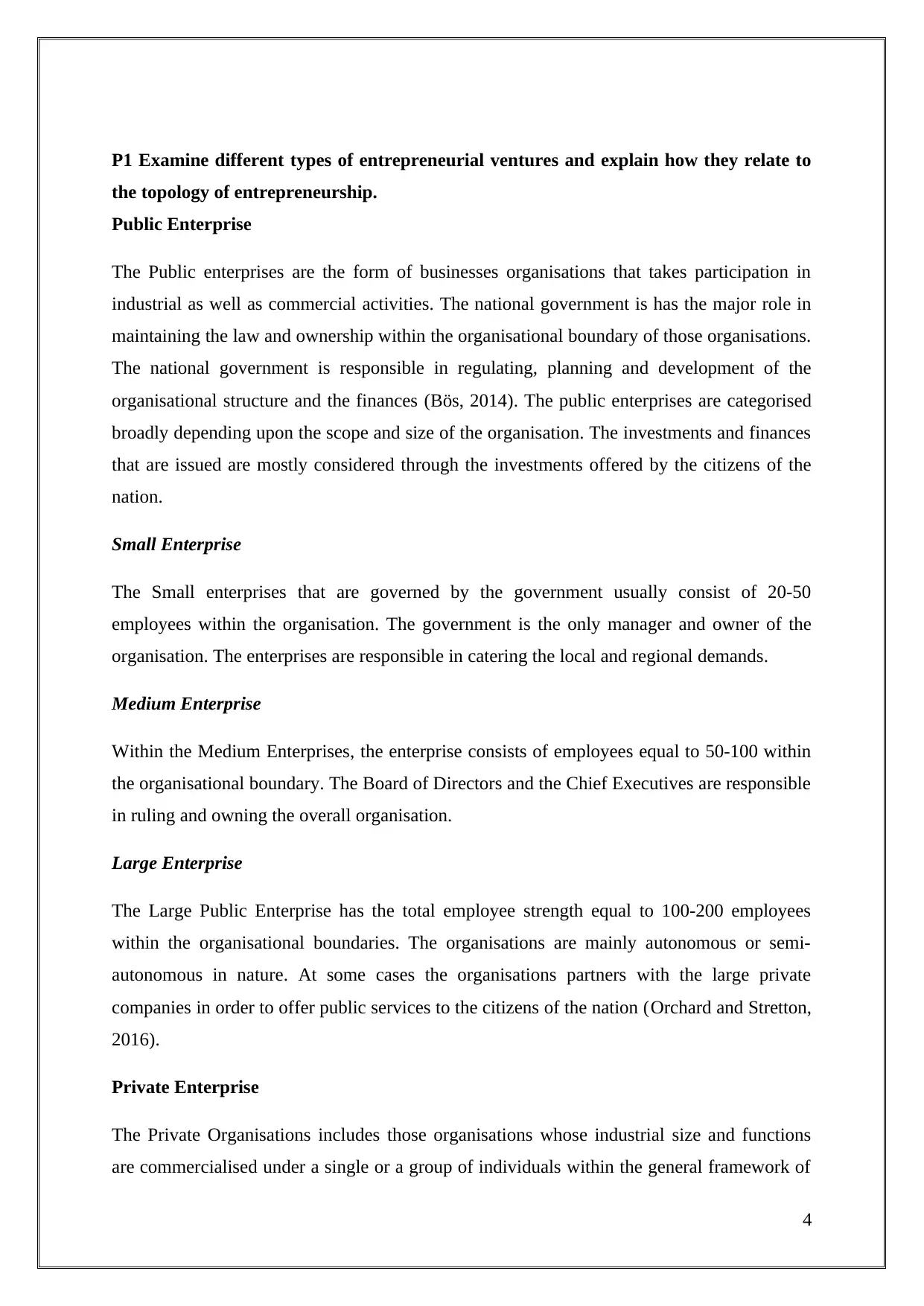
P1 Examine different types of entrepreneurial ventures and explain how they relate to
the topology of entrepreneurship.
Public Enterprise
The Public enterprises are the form of businesses organisations that takes participation in
industrial as well as commercial activities. The national government is has the major role in
maintaining the law and ownership within the organisational boundary of those organisations.
The national government is responsible in regulating, planning and development of the
organisational structure and the finances (Bös, 2014). The public enterprises are categorised
broadly depending upon the scope and size of the organisation. The investments and finances
that are issued are mostly considered through the investments offered by the citizens of the
nation.
Small Enterprise
The Small enterprises that are governed by the government usually consist of 20-50
employees within the organisation. The government is the only manager and owner of the
organisation. The enterprises are responsible in catering the local and regional demands.
Medium Enterprise
Within the Medium Enterprises, the enterprise consists of employees equal to 50-100 within
the organisational boundary. The Board of Directors and the Chief Executives are responsible
in ruling and owning the overall organisation.
Large Enterprise
The Large Public Enterprise has the total employee strength equal to 100-200 employees
within the organisational boundaries. The organisations are mainly autonomous or semi-
autonomous in nature. At some cases the organisations partners with the large private
companies in order to offer public services to the citizens of the nation (Orchard and Stretton,
2016).
Private Enterprise
The Private Organisations includes those organisations whose industrial size and functions
are commercialised under a single or a group of individuals within the general framework of
4
the topology of entrepreneurship.
Public Enterprise
The Public enterprises are the form of businesses organisations that takes participation in
industrial as well as commercial activities. The national government is has the major role in
maintaining the law and ownership within the organisational boundary of those organisations.
The national government is responsible in regulating, planning and development of the
organisational structure and the finances (Bös, 2014). The public enterprises are categorised
broadly depending upon the scope and size of the organisation. The investments and finances
that are issued are mostly considered through the investments offered by the citizens of the
nation.
Small Enterprise
The Small enterprises that are governed by the government usually consist of 20-50
employees within the organisation. The government is the only manager and owner of the
organisation. The enterprises are responsible in catering the local and regional demands.
Medium Enterprise
Within the Medium Enterprises, the enterprise consists of employees equal to 50-100 within
the organisational boundary. The Board of Directors and the Chief Executives are responsible
in ruling and owning the overall organisation.
Large Enterprise
The Large Public Enterprise has the total employee strength equal to 100-200 employees
within the organisational boundaries. The organisations are mainly autonomous or semi-
autonomous in nature. At some cases the organisations partners with the large private
companies in order to offer public services to the citizens of the nation (Orchard and Stretton,
2016).
Private Enterprise
The Private Organisations includes those organisations whose industrial size and functions
are commercialised under a single or a group of individuals within the general framework of
4
Paraphrase This Document
Need a fresh take? Get an instant paraphrase of this document with our AI Paraphraser
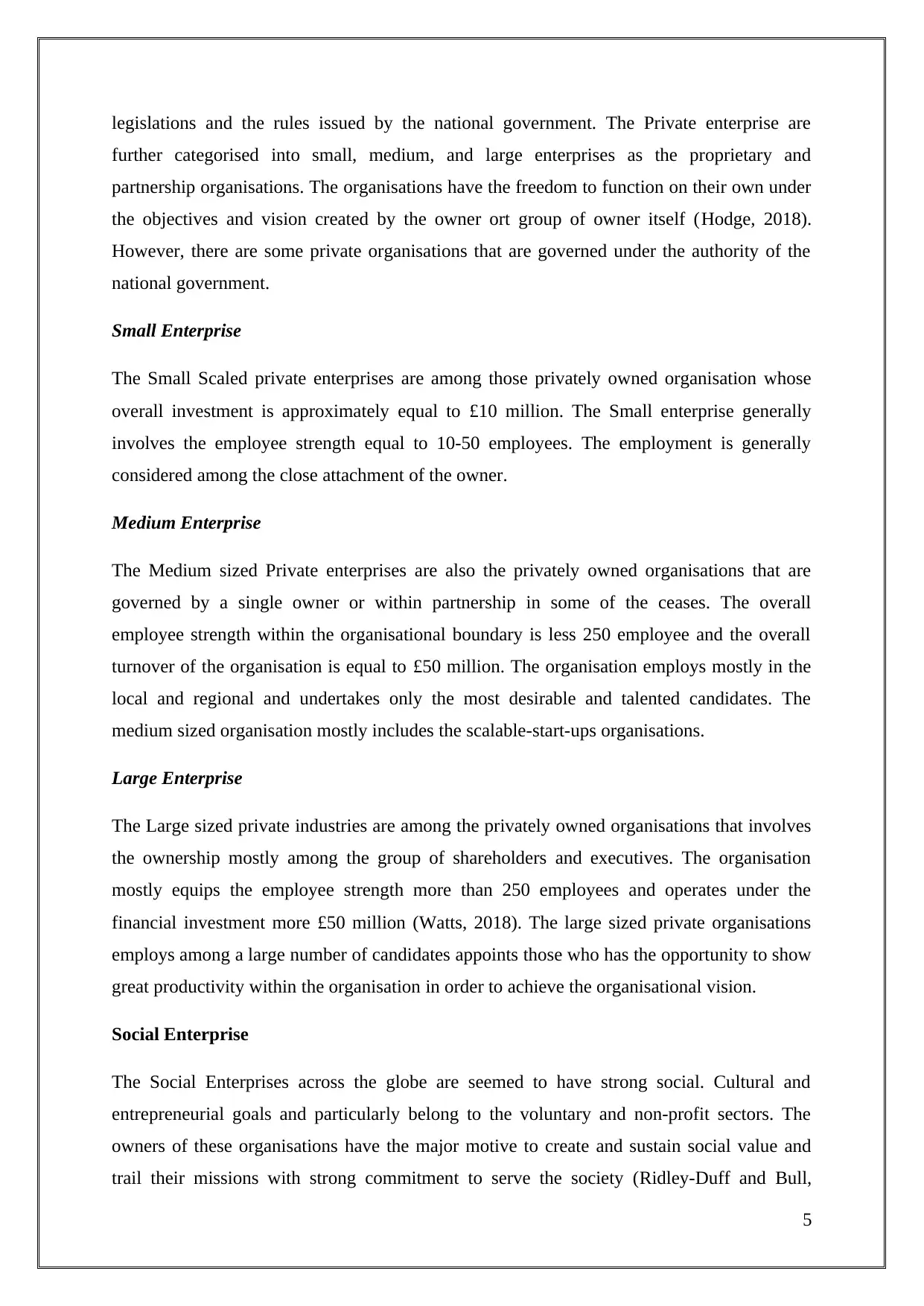
legislations and the rules issued by the national government. The Private enterprise are
further categorised into small, medium, and large enterprises as the proprietary and
partnership organisations. The organisations have the freedom to function on their own under
the objectives and vision created by the owner ort group of owner itself (Hodge, 2018).
However, there are some private organisations that are governed under the authority of the
national government.
Small Enterprise
The Small Scaled private enterprises are among those privately owned organisation whose
overall investment is approximately equal to £10 million. The Small enterprise generally
involves the employee strength equal to 10-50 employees. The employment is generally
considered among the close attachment of the owner.
Medium Enterprise
The Medium sized Private enterprises are also the privately owned organisations that are
governed by a single owner or within partnership in some of the ceases. The overall
employee strength within the organisational boundary is less 250 employee and the overall
turnover of the organisation is equal to £50 million. The organisation employs mostly in the
local and regional and undertakes only the most desirable and talented candidates. The
medium sized organisation mostly includes the scalable-start-ups organisations.
Large Enterprise
The Large sized private industries are among the privately owned organisations that involves
the ownership mostly among the group of shareholders and executives. The organisation
mostly equips the employee strength more than 250 employees and operates under the
financial investment more £50 million (Watts, 2018). The large sized private organisations
employs among a large number of candidates appoints those who has the opportunity to show
great productivity within the organisation in order to achieve the organisational vision.
Social Enterprise
The Social Enterprises across the globe are seemed to have strong social. Cultural and
entrepreneurial goals and particularly belong to the voluntary and non-profit sectors. The
owners of these organisations have the major motive to create and sustain social value and
trail their missions with strong commitment to serve the society (Ridley-Duff and Bull,
5
further categorised into small, medium, and large enterprises as the proprietary and
partnership organisations. The organisations have the freedom to function on their own under
the objectives and vision created by the owner ort group of owner itself (Hodge, 2018).
However, there are some private organisations that are governed under the authority of the
national government.
Small Enterprise
The Small Scaled private enterprises are among those privately owned organisation whose
overall investment is approximately equal to £10 million. The Small enterprise generally
involves the employee strength equal to 10-50 employees. The employment is generally
considered among the close attachment of the owner.
Medium Enterprise
The Medium sized Private enterprises are also the privately owned organisations that are
governed by a single owner or within partnership in some of the ceases. The overall
employee strength within the organisational boundary is less 250 employee and the overall
turnover of the organisation is equal to £50 million. The organisation employs mostly in the
local and regional and undertakes only the most desirable and talented candidates. The
medium sized organisation mostly includes the scalable-start-ups organisations.
Large Enterprise
The Large sized private industries are among the privately owned organisations that involves
the ownership mostly among the group of shareholders and executives. The organisation
mostly equips the employee strength more than 250 employees and operates under the
financial investment more £50 million (Watts, 2018). The large sized private organisations
employs among a large number of candidates appoints those who has the opportunity to show
great productivity within the organisation in order to achieve the organisational vision.
Social Enterprise
The Social Enterprises across the globe are seemed to have strong social. Cultural and
entrepreneurial goals and particularly belong to the voluntary and non-profit sectors. The
owners of these organisations have the major motive to create and sustain social value and
trail their missions with strong commitment to serve the society (Ridley-Duff and Bull,
5
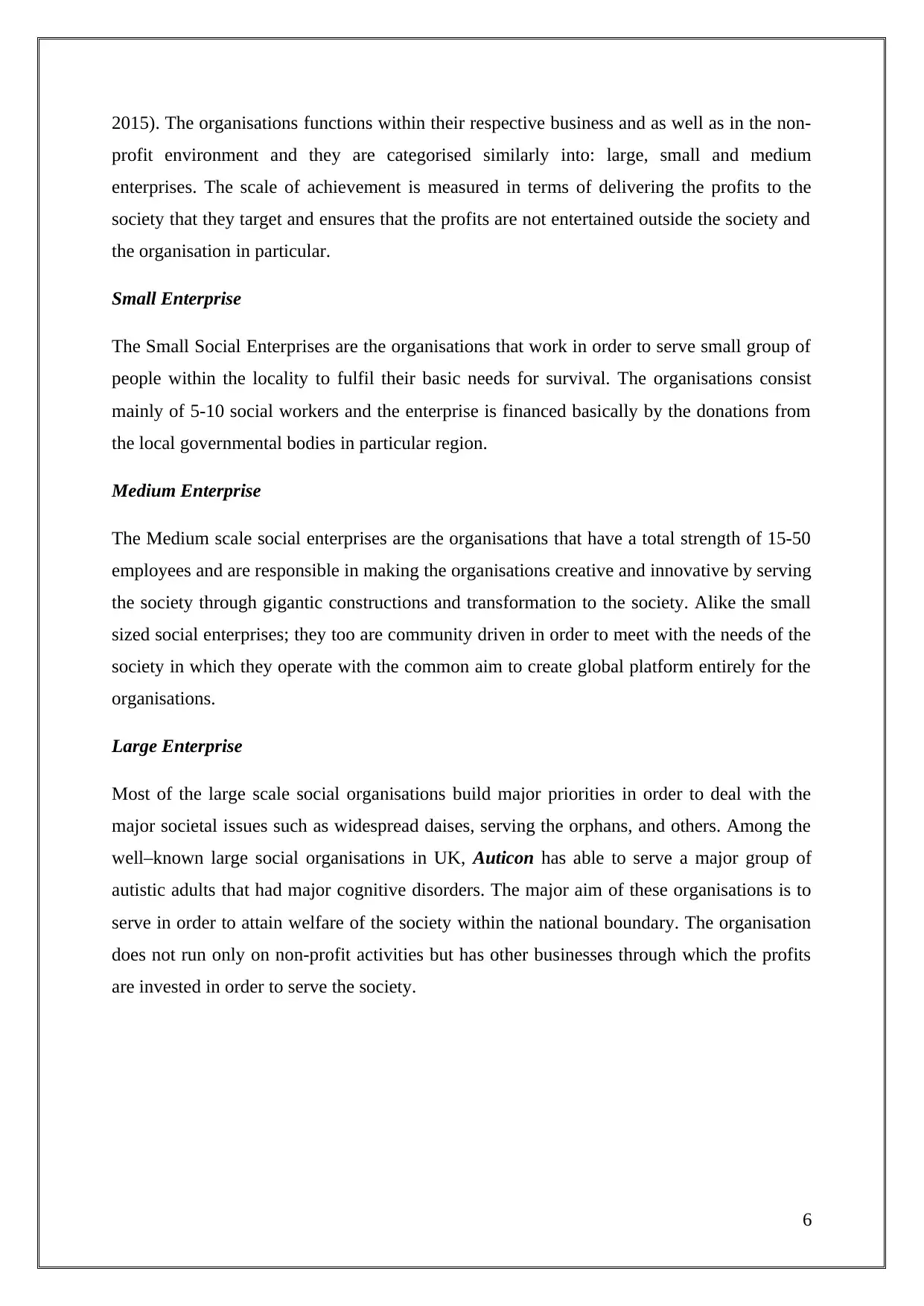
2015). The organisations functions within their respective business and as well as in the non-
profit environment and they are categorised similarly into: large, small and medium
enterprises. The scale of achievement is measured in terms of delivering the profits to the
society that they target and ensures that the profits are not entertained outside the society and
the organisation in particular.
Small Enterprise
The Small Social Enterprises are the organisations that work in order to serve small group of
people within the locality to fulfil their basic needs for survival. The organisations consist
mainly of 5-10 social workers and the enterprise is financed basically by the donations from
the local governmental bodies in particular region.
Medium Enterprise
The Medium scale social enterprises are the organisations that have a total strength of 15-50
employees and are responsible in making the organisations creative and innovative by serving
the society through gigantic constructions and transformation to the society. Alike the small
sized social enterprises; they too are community driven in order to meet with the needs of the
society in which they operate with the common aim to create global platform entirely for the
organisations.
Large Enterprise
Most of the large scale social organisations build major priorities in order to deal with the
major societal issues such as widespread daises, serving the orphans, and others. Among the
well–known large social organisations in UK, Auticon has able to serve a major group of
autistic adults that had major cognitive disorders. The major aim of these organisations is to
serve in order to attain welfare of the society within the national boundary. The organisation
does not run only on non-profit activities but has other businesses through which the profits
are invested in order to serve the society.
6
profit environment and they are categorised similarly into: large, small and medium
enterprises. The scale of achievement is measured in terms of delivering the profits to the
society that they target and ensures that the profits are not entertained outside the society and
the organisation in particular.
Small Enterprise
The Small Social Enterprises are the organisations that work in order to serve small group of
people within the locality to fulfil their basic needs for survival. The organisations consist
mainly of 5-10 social workers and the enterprise is financed basically by the donations from
the local governmental bodies in particular region.
Medium Enterprise
The Medium scale social enterprises are the organisations that have a total strength of 15-50
employees and are responsible in making the organisations creative and innovative by serving
the society through gigantic constructions and transformation to the society. Alike the small
sized social enterprises; they too are community driven in order to meet with the needs of the
society in which they operate with the common aim to create global platform entirely for the
organisations.
Large Enterprise
Most of the large scale social organisations build major priorities in order to deal with the
major societal issues such as widespread daises, serving the orphans, and others. Among the
well–known large social organisations in UK, Auticon has able to serve a major group of
autistic adults that had major cognitive disorders. The major aim of these organisations is to
serve in order to attain welfare of the society within the national boundary. The organisation
does not run only on non-profit activities but has other businesses through which the profits
are invested in order to serve the society.
6
⊘ This is a preview!⊘
Do you want full access?
Subscribe today to unlock all pages.

Trusted by 1+ million students worldwide
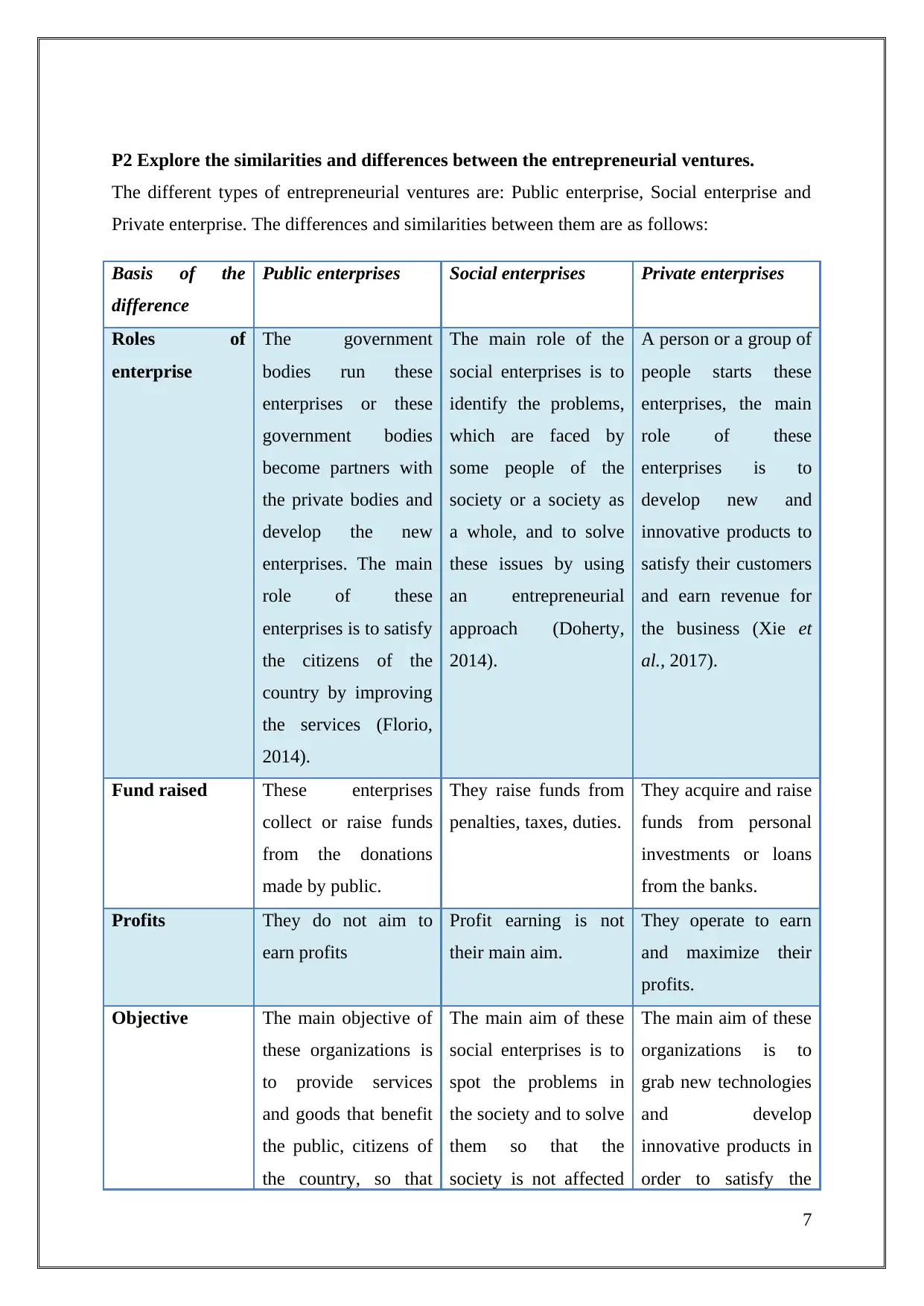
P2 Explore the similarities and differences between the entrepreneurial ventures.
The different types of entrepreneurial ventures are: Public enterprise, Social enterprise and
Private enterprise. The differences and similarities between them are as follows:
Basis of the
difference
Public enterprises Social enterprises Private enterprises
Roles of
enterprise
The government
bodies run these
enterprises or these
government bodies
become partners with
the private bodies and
develop the new
enterprises. The main
role of these
enterprises is to satisfy
the citizens of the
country by improving
the services (Florio,
2014).
The main role of the
social enterprises is to
identify the problems,
which are faced by
some people of the
society or a society as
a whole, and to solve
these issues by using
an entrepreneurial
approach (Doherty,
2014).
A person or a group of
people starts these
enterprises, the main
role of these
enterprises is to
develop new and
innovative products to
satisfy their customers
and earn revenue for
the business (Xie et
al., 2017).
Fund raised These enterprises
collect or raise funds
from the donations
made by public.
They raise funds from
penalties, taxes, duties.
They acquire and raise
funds from personal
investments or loans
from the banks.
Profits They do not aim to
earn profits
Profit earning is not
their main aim.
They operate to earn
and maximize their
profits.
Objective The main objective of
these organizations is
to provide services
and goods that benefit
the public, citizens of
the country, so that
The main aim of these
social enterprises is to
spot the problems in
the society and to solve
them so that the
society is not affected
The main aim of these
organizations is to
grab new technologies
and develop
innovative products in
order to satisfy the
7
The different types of entrepreneurial ventures are: Public enterprise, Social enterprise and
Private enterprise. The differences and similarities between them are as follows:
Basis of the
difference
Public enterprises Social enterprises Private enterprises
Roles of
enterprise
The government
bodies run these
enterprises or these
government bodies
become partners with
the private bodies and
develop the new
enterprises. The main
role of these
enterprises is to satisfy
the citizens of the
country by improving
the services (Florio,
2014).
The main role of the
social enterprises is to
identify the problems,
which are faced by
some people of the
society or a society as
a whole, and to solve
these issues by using
an entrepreneurial
approach (Doherty,
2014).
A person or a group of
people starts these
enterprises, the main
role of these
enterprises is to
develop new and
innovative products to
satisfy their customers
and earn revenue for
the business (Xie et
al., 2017).
Fund raised These enterprises
collect or raise funds
from the donations
made by public.
They raise funds from
penalties, taxes, duties.
They acquire and raise
funds from personal
investments or loans
from the banks.
Profits They do not aim to
earn profits
Profit earning is not
their main aim.
They operate to earn
and maximize their
profits.
Objective The main objective of
these organizations is
to provide services
and goods that benefit
the public, citizens of
the country, so that
The main aim of these
social enterprises is to
spot the problems in
the society and to solve
them so that the
society is not affected
The main aim of these
organizations is to
grab new technologies
and develop
innovative products in
order to satisfy the
7
Paraphrase This Document
Need a fresh take? Get an instant paraphrase of this document with our AI Paraphraser

they are happy and
satisfied and all their
requirements are met.
by the problems
(Ridley-Duff and Bull,
2015).
customers, so that
they can grow and put
competitors’ at bay.
They desire to sell
their products and
services and generate
a lot of revenue
through that and
flourish their
enterprises.
Hiring Employees are not hired
so often, it is a long, and
a delayed process as it
takes a long time to
generate a vacancy.
Same is the case here for
social enterprises.
They hold recruitment
processes after a definite
period of time and take
new employees and
conduct their trainings.
Deciding
objectives
They do not set or
decide their own goals
as they meet the
requirements of the
citizens.
They also do not set their
goals as they solve the
conflicts arising and it is
not possible to generate
procedures to solve a
conflict before they have
even generated.
They set their own goals
and with respect to that
they train their
employees so that the
employees work hard
and achieve the goals of
the organization.
Benefits of
working
Job security, great
allowances, and
retirement facilities and
so on
Identified by people,
safety, security and so on
Good amounts of salary,
competitive work
environment, incentives
and so on
Basis of
promotions given
Number of years or
working, that is based
on seniority of the
employee
Based on seniority and
popularity
Based on performance
and talents
Table 1: Differences between the public, social and private enterprises
(Source: Created by the learner)
Similarities between the public, social and private enterprises are as follows:
8
satisfied and all their
requirements are met.
by the problems
(Ridley-Duff and Bull,
2015).
customers, so that
they can grow and put
competitors’ at bay.
They desire to sell
their products and
services and generate
a lot of revenue
through that and
flourish their
enterprises.
Hiring Employees are not hired
so often, it is a long, and
a delayed process as it
takes a long time to
generate a vacancy.
Same is the case here for
social enterprises.
They hold recruitment
processes after a definite
period of time and take
new employees and
conduct their trainings.
Deciding
objectives
They do not set or
decide their own goals
as they meet the
requirements of the
citizens.
They also do not set their
goals as they solve the
conflicts arising and it is
not possible to generate
procedures to solve a
conflict before they have
even generated.
They set their own goals
and with respect to that
they train their
employees so that the
employees work hard
and achieve the goals of
the organization.
Benefits of
working
Job security, great
allowances, and
retirement facilities and
so on
Identified by people,
safety, security and so on
Good amounts of salary,
competitive work
environment, incentives
and so on
Basis of
promotions given
Number of years or
working, that is based
on seniority of the
employee
Based on seniority and
popularity
Based on performance
and talents
Table 1: Differences between the public, social and private enterprises
(Source: Created by the learner)
Similarities between the public, social and private enterprises are as follows:
8
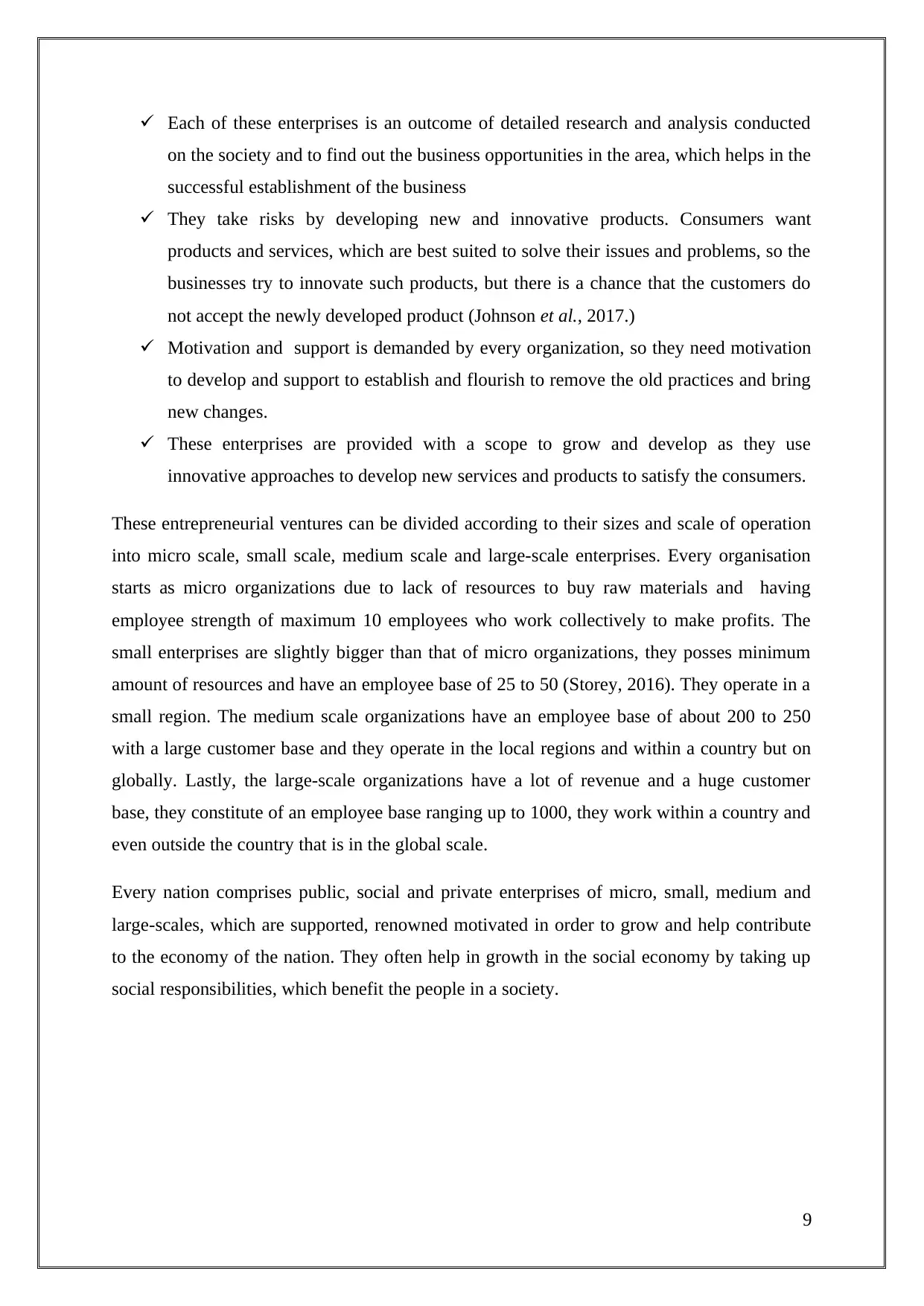
Each of these enterprises is an outcome of detailed research and analysis conducted
on the society and to find out the business opportunities in the area, which helps in the
successful establishment of the business
They take risks by developing new and innovative products. Consumers want
products and services, which are best suited to solve their issues and problems, so the
businesses try to innovate such products, but there is a chance that the customers do
not accept the newly developed product (Johnson et al., 2017.)
Motivation and support is demanded by every organization, so they need motivation
to develop and support to establish and flourish to remove the old practices and bring
new changes.
These enterprises are provided with a scope to grow and develop as they use
innovative approaches to develop new services and products to satisfy the consumers.
These entrepreneurial ventures can be divided according to their sizes and scale of operation
into micro scale, small scale, medium scale and large-scale enterprises. Every organisation
starts as micro organizations due to lack of resources to buy raw materials and having
employee strength of maximum 10 employees who work collectively to make profits. The
small enterprises are slightly bigger than that of micro organizations, they posses minimum
amount of resources and have an employee base of 25 to 50 (Storey, 2016). They operate in a
small region. The medium scale organizations have an employee base of about 200 to 250
with a large customer base and they operate in the local regions and within a country but on
globally. Lastly, the large-scale organizations have a lot of revenue and a huge customer
base, they constitute of an employee base ranging up to 1000, they work within a country and
even outside the country that is in the global scale.
Every nation comprises public, social and private enterprises of micro, small, medium and
large-scales, which are supported, renowned motivated in order to grow and help contribute
to the economy of the nation. They often help in growth in the social economy by taking up
social responsibilities, which benefit the people in a society.
9
on the society and to find out the business opportunities in the area, which helps in the
successful establishment of the business
They take risks by developing new and innovative products. Consumers want
products and services, which are best suited to solve their issues and problems, so the
businesses try to innovate such products, but there is a chance that the customers do
not accept the newly developed product (Johnson et al., 2017.)
Motivation and support is demanded by every organization, so they need motivation
to develop and support to establish and flourish to remove the old practices and bring
new changes.
These enterprises are provided with a scope to grow and develop as they use
innovative approaches to develop new services and products to satisfy the consumers.
These entrepreneurial ventures can be divided according to their sizes and scale of operation
into micro scale, small scale, medium scale and large-scale enterprises. Every organisation
starts as micro organizations due to lack of resources to buy raw materials and having
employee strength of maximum 10 employees who work collectively to make profits. The
small enterprises are slightly bigger than that of micro organizations, they posses minimum
amount of resources and have an employee base of 25 to 50 (Storey, 2016). They operate in a
small region. The medium scale organizations have an employee base of about 200 to 250
with a large customer base and they operate in the local regions and within a country but on
globally. Lastly, the large-scale organizations have a lot of revenue and a huge customer
base, they constitute of an employee base ranging up to 1000, they work within a country and
even outside the country that is in the global scale.
Every nation comprises public, social and private enterprises of micro, small, medium and
large-scales, which are supported, renowned motivated in order to grow and help contribute
to the economy of the nation. They often help in growth in the social economy by taking up
social responsibilities, which benefit the people in a society.
9
⊘ This is a preview!⊘
Do you want full access?
Subscribe today to unlock all pages.

Trusted by 1+ million students worldwide
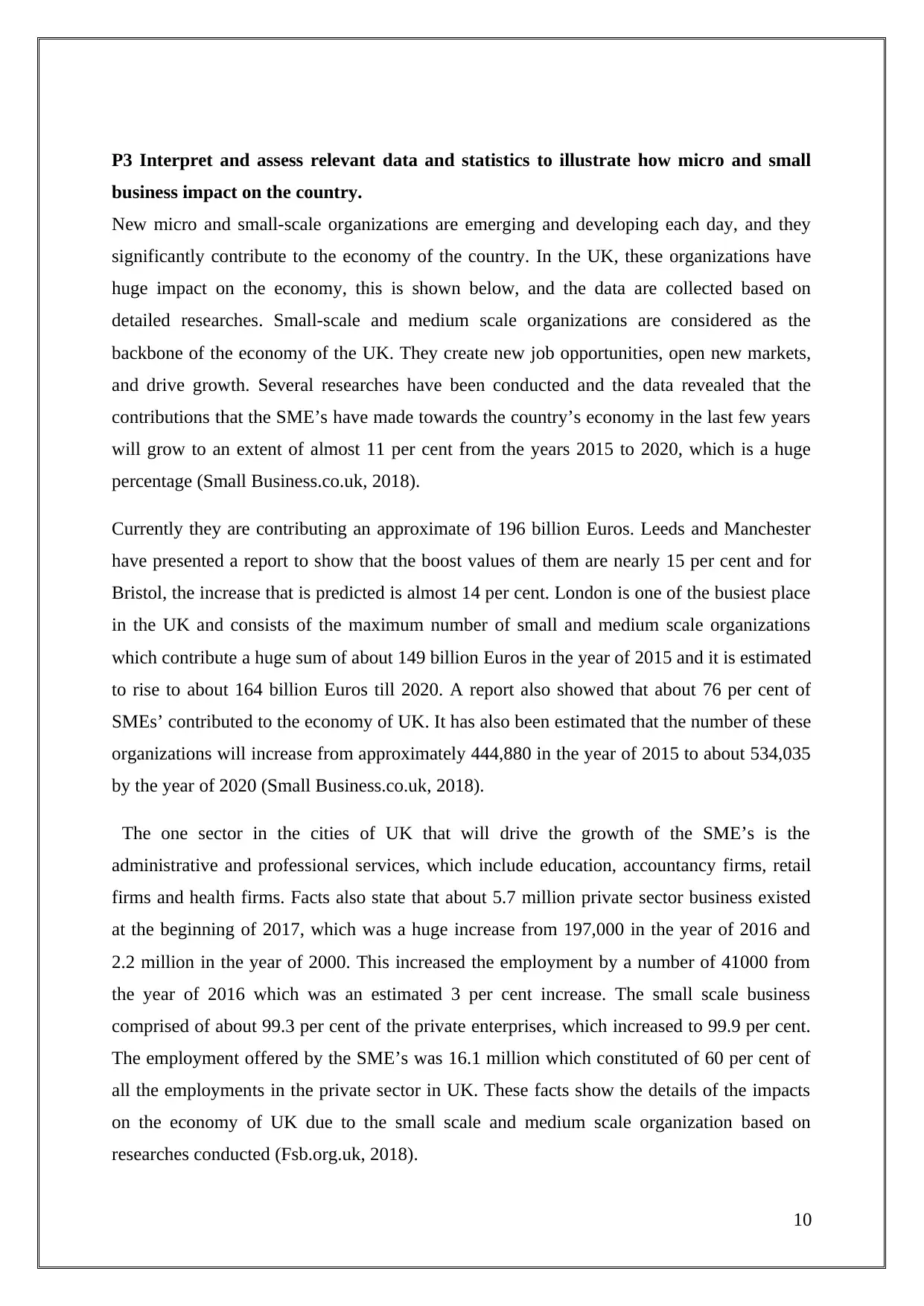
P3 Interpret and assess relevant data and statistics to illustrate how micro and small
business impact on the country.
New micro and small-scale organizations are emerging and developing each day, and they
significantly contribute to the economy of the country. In the UK, these organizations have
huge impact on the economy, this is shown below, and the data are collected based on
detailed researches. Small-scale and medium scale organizations are considered as the
backbone of the economy of the UK. They create new job opportunities, open new markets,
and drive growth. Several researches have been conducted and the data revealed that the
contributions that the SME’s have made towards the country’s economy in the last few years
will grow to an extent of almost 11 per cent from the years 2015 to 2020, which is a huge
percentage (Small Business.co.uk, 2018).
Currently they are contributing an approximate of 196 billion Euros. Leeds and Manchester
have presented a report to show that the boost values of them are nearly 15 per cent and for
Bristol, the increase that is predicted is almost 14 per cent. London is one of the busiest place
in the UK and consists of the maximum number of small and medium scale organizations
which contribute a huge sum of about 149 billion Euros in the year of 2015 and it is estimated
to rise to about 164 billion Euros till 2020. A report also showed that about 76 per cent of
SMEs’ contributed to the economy of UK. It has also been estimated that the number of these
organizations will increase from approximately 444,880 in the year of 2015 to about 534,035
by the year of 2020 (Small Business.co.uk, 2018).
The one sector in the cities of UK that will drive the growth of the SME’s is the
administrative and professional services, which include education, accountancy firms, retail
firms and health firms. Facts also state that about 5.7 million private sector business existed
at the beginning of 2017, which was a huge increase from 197,000 in the year of 2016 and
2.2 million in the year of 2000. This increased the employment by a number of 41000 from
the year of 2016 which was an estimated 3 per cent increase. The small scale business
comprised of about 99.3 per cent of the private enterprises, which increased to 99.9 per cent.
The employment offered by the SME’s was 16.1 million which constituted of 60 per cent of
all the employments in the private sector in UK. These facts show the details of the impacts
on the economy of UK due to the small scale and medium scale organization based on
researches conducted (Fsb.org.uk, 2018).
10
business impact on the country.
New micro and small-scale organizations are emerging and developing each day, and they
significantly contribute to the economy of the country. In the UK, these organizations have
huge impact on the economy, this is shown below, and the data are collected based on
detailed researches. Small-scale and medium scale organizations are considered as the
backbone of the economy of the UK. They create new job opportunities, open new markets,
and drive growth. Several researches have been conducted and the data revealed that the
contributions that the SME’s have made towards the country’s economy in the last few years
will grow to an extent of almost 11 per cent from the years 2015 to 2020, which is a huge
percentage (Small Business.co.uk, 2018).
Currently they are contributing an approximate of 196 billion Euros. Leeds and Manchester
have presented a report to show that the boost values of them are nearly 15 per cent and for
Bristol, the increase that is predicted is almost 14 per cent. London is one of the busiest place
in the UK and consists of the maximum number of small and medium scale organizations
which contribute a huge sum of about 149 billion Euros in the year of 2015 and it is estimated
to rise to about 164 billion Euros till 2020. A report also showed that about 76 per cent of
SMEs’ contributed to the economy of UK. It has also been estimated that the number of these
organizations will increase from approximately 444,880 in the year of 2015 to about 534,035
by the year of 2020 (Small Business.co.uk, 2018).
The one sector in the cities of UK that will drive the growth of the SME’s is the
administrative and professional services, which include education, accountancy firms, retail
firms and health firms. Facts also state that about 5.7 million private sector business existed
at the beginning of 2017, which was a huge increase from 197,000 in the year of 2016 and
2.2 million in the year of 2000. This increased the employment by a number of 41000 from
the year of 2016 which was an estimated 3 per cent increase. The small scale business
comprised of about 99.3 per cent of the private enterprises, which increased to 99.9 per cent.
The employment offered by the SME’s was 16.1 million which constituted of 60 per cent of
all the employments in the private sector in UK. These facts show the details of the impacts
on the economy of UK due to the small scale and medium scale organization based on
researches conducted (Fsb.org.uk, 2018).
10
Paraphrase This Document
Need a fresh take? Get an instant paraphrase of this document with our AI Paraphraser
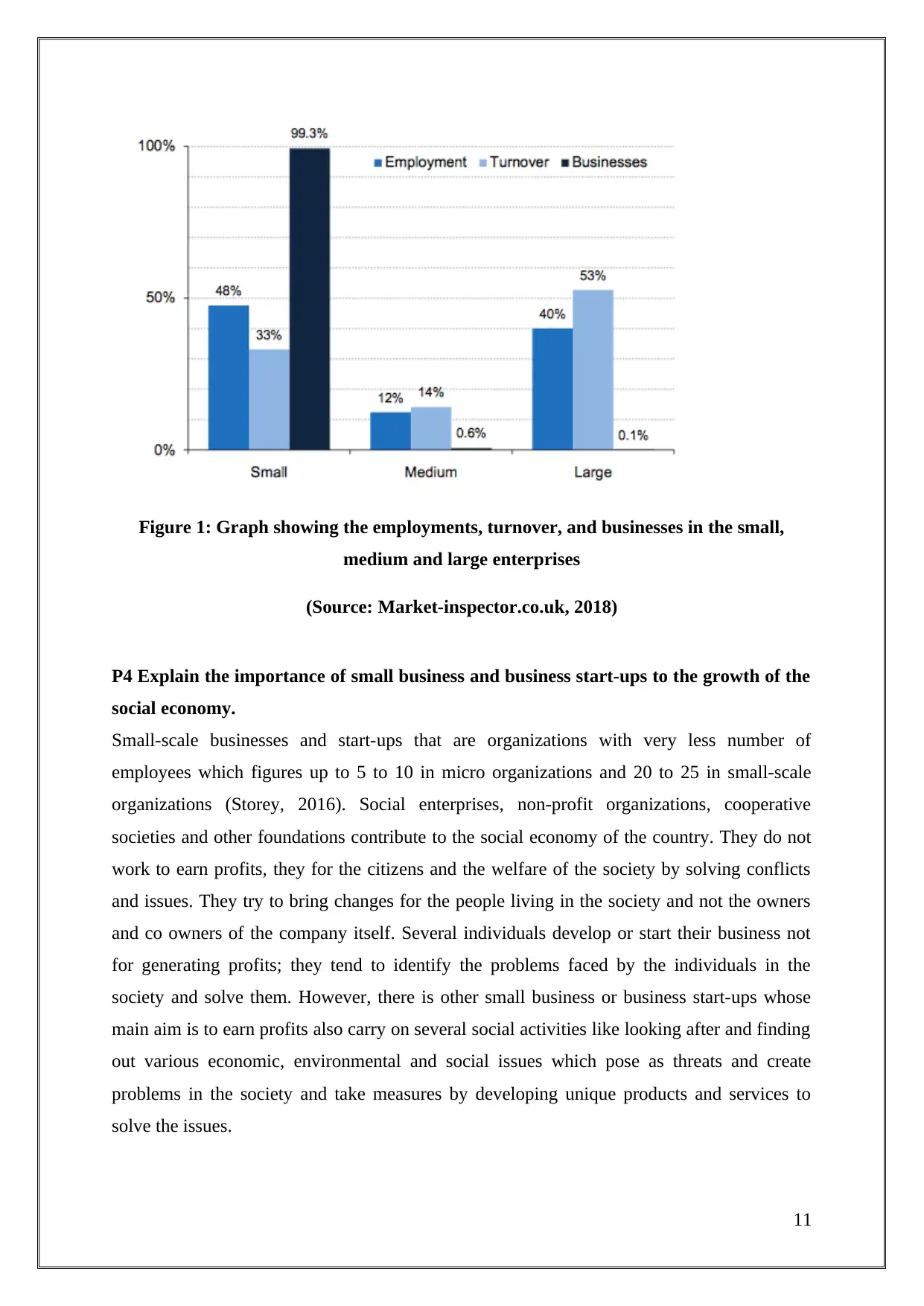
Figure 1: Graph showing the employments, turnover, and businesses in the small,
medium and large enterprises
(Source: Market-inspector.co.uk, 2018)
P4 Explain the importance of small business and business start-ups to the growth of the
social economy.
Small-scale businesses and start-ups that are organizations with very less number of
employees which figures up to 5 to 10 in micro organizations and 20 to 25 in small-scale
organizations (Storey, 2016). Social enterprises, non-profit organizations, cooperative
societies and other foundations contribute to the social economy of the country. They do not
work to earn profits, they for the citizens and the welfare of the society by solving conflicts
and issues. They try to bring changes for the people living in the society and not the owners
and co owners of the company itself. Several individuals develop or start their business not
for generating profits; they tend to identify the problems faced by the individuals in the
society and solve them. However, there is other small business or business start-ups whose
main aim is to earn profits also carry on several social activities like looking after and finding
out various economic, environmental and social issues which pose as threats and create
problems in the society and take measures by developing unique products and services to
solve the issues.
11
medium and large enterprises
(Source: Market-inspector.co.uk, 2018)
P4 Explain the importance of small business and business start-ups to the growth of the
social economy.
Small-scale businesses and start-ups that are organizations with very less number of
employees which figures up to 5 to 10 in micro organizations and 20 to 25 in small-scale
organizations (Storey, 2016). Social enterprises, non-profit organizations, cooperative
societies and other foundations contribute to the social economy of the country. They do not
work to earn profits, they for the citizens and the welfare of the society by solving conflicts
and issues. They try to bring changes for the people living in the society and not the owners
and co owners of the company itself. Several individuals develop or start their business not
for generating profits; they tend to identify the problems faced by the individuals in the
society and solve them. However, there is other small business or business start-ups whose
main aim is to earn profits also carry on several social activities like looking after and finding
out various economic, environmental and social issues which pose as threats and create
problems in the society and take measures by developing unique products and services to
solve the issues.
11
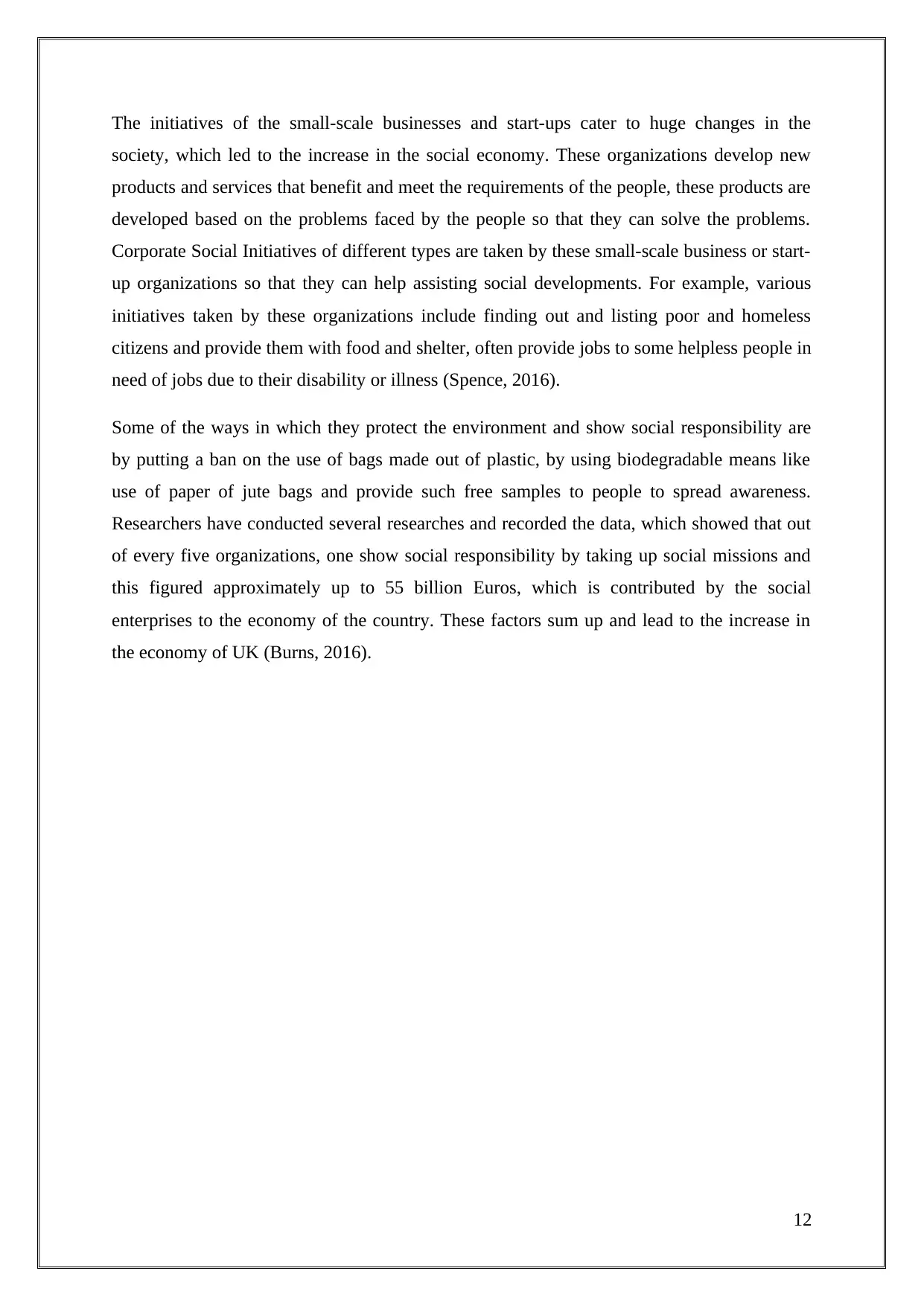
The initiatives of the small-scale businesses and start-ups cater to huge changes in the
society, which led to the increase in the social economy. These organizations develop new
products and services that benefit and meet the requirements of the people, these products are
developed based on the problems faced by the people so that they can solve the problems.
Corporate Social Initiatives of different types are taken by these small-scale business or start-
up organizations so that they can help assisting social developments. For example, various
initiatives taken by these organizations include finding out and listing poor and homeless
citizens and provide them with food and shelter, often provide jobs to some helpless people in
need of jobs due to their disability or illness (Spence, 2016).
Some of the ways in which they protect the environment and show social responsibility are
by putting a ban on the use of bags made out of plastic, by using biodegradable means like
use of paper of jute bags and provide such free samples to people to spread awareness.
Researchers have conducted several researches and recorded the data, which showed that out
of every five organizations, one show social responsibility by taking up social missions and
this figured approximately up to 55 billion Euros, which is contributed by the social
enterprises to the economy of the country. These factors sum up and lead to the increase in
the economy of UK (Burns, 2016).
12
society, which led to the increase in the social economy. These organizations develop new
products and services that benefit and meet the requirements of the people, these products are
developed based on the problems faced by the people so that they can solve the problems.
Corporate Social Initiatives of different types are taken by these small-scale business or start-
up organizations so that they can help assisting social developments. For example, various
initiatives taken by these organizations include finding out and listing poor and homeless
citizens and provide them with food and shelter, often provide jobs to some helpless people in
need of jobs due to their disability or illness (Spence, 2016).
Some of the ways in which they protect the environment and show social responsibility are
by putting a ban on the use of bags made out of plastic, by using biodegradable means like
use of paper of jute bags and provide such free samples to people to spread awareness.
Researchers have conducted several researches and recorded the data, which showed that out
of every five organizations, one show social responsibility by taking up social missions and
this figured approximately up to 55 billion Euros, which is contributed by the social
enterprises to the economy of the country. These factors sum up and lead to the increase in
the economy of UK (Burns, 2016).
12
⊘ This is a preview!⊘
Do you want full access?
Subscribe today to unlock all pages.

Trusted by 1+ million students worldwide
1 out of 15
Related Documents
Your All-in-One AI-Powered Toolkit for Academic Success.
+13062052269
info@desklib.com
Available 24*7 on WhatsApp / Email
![[object Object]](/_next/static/media/star-bottom.7253800d.svg)
Unlock your academic potential
Copyright © 2020–2025 A2Z Services. All Rights Reserved. Developed and managed by ZUCOL.



